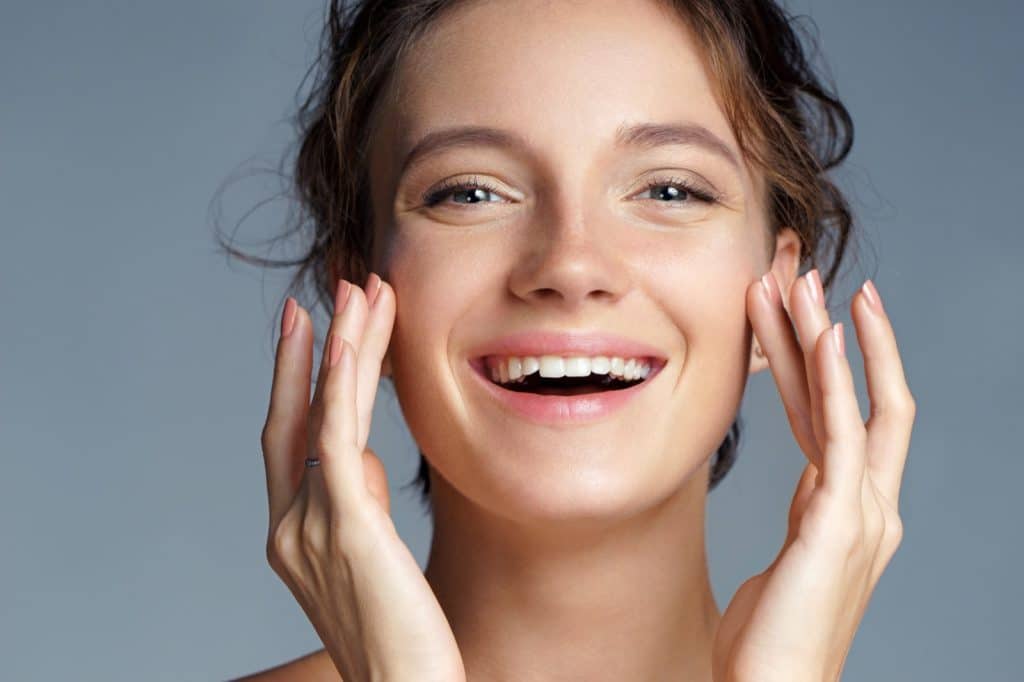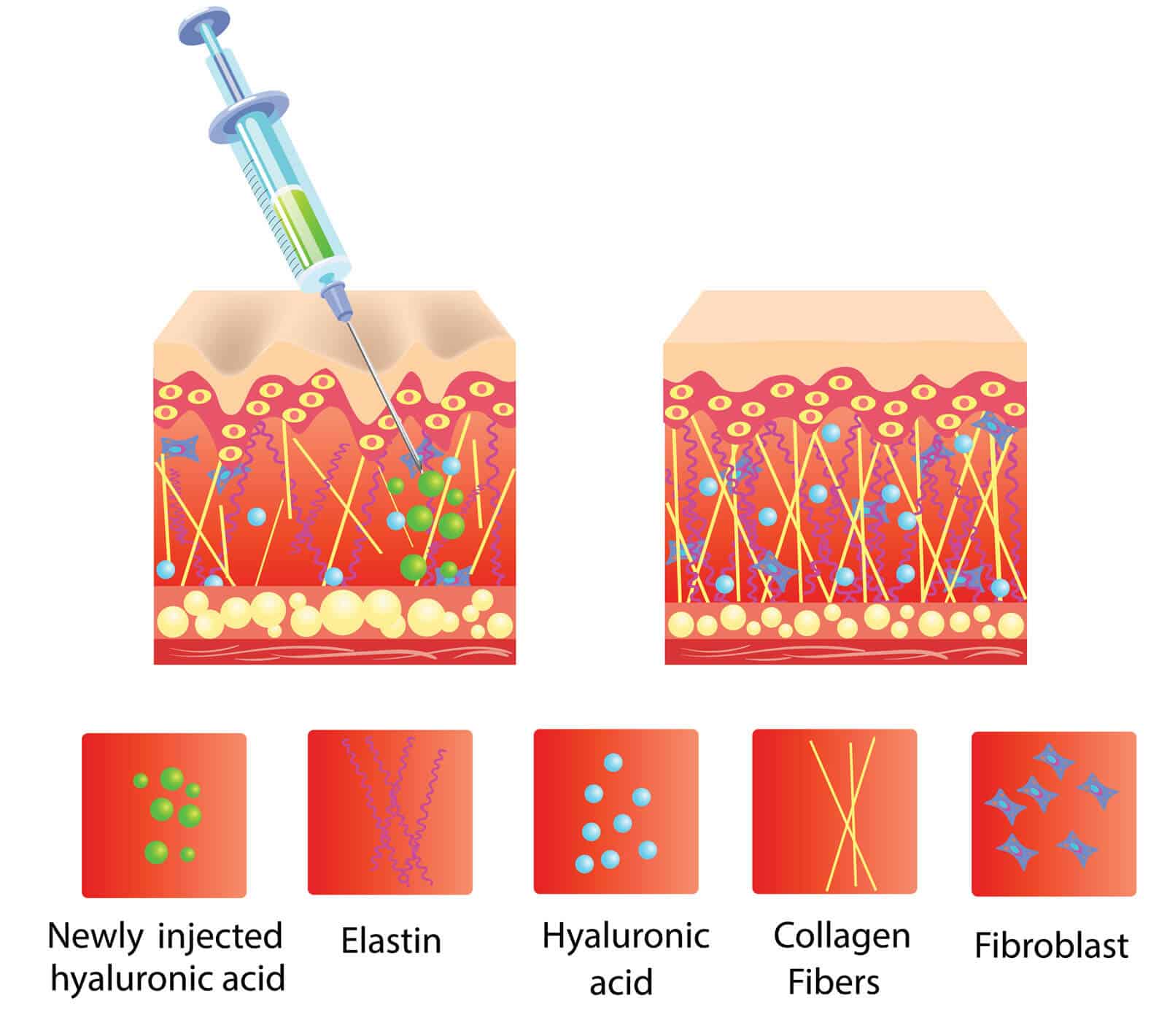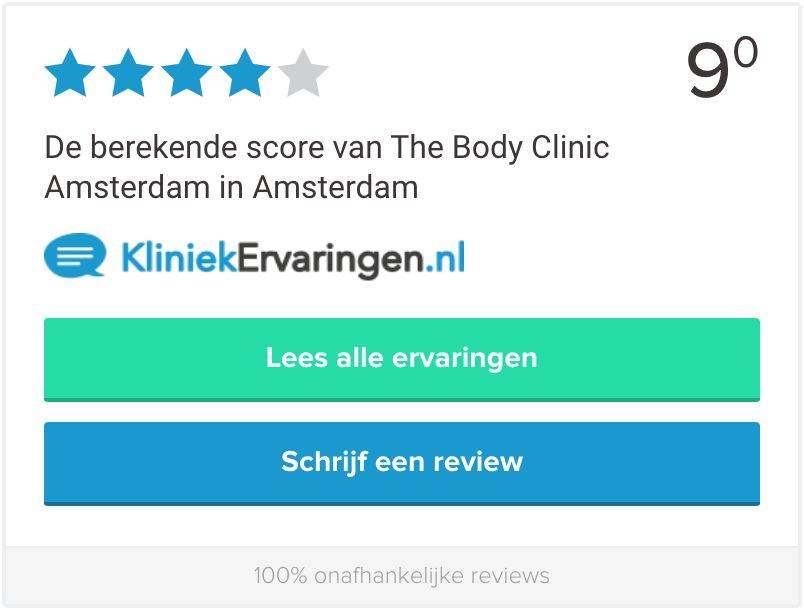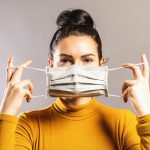Side effect may occur
A Fillers treatment generally carries very few risks, but it is possible that a side effect may occur. In the article below, we will discuss possible side effects of a Filler treatments and I want to give you some more background information about Filler treatments in general.
Side effects of filler treatment
Common side effects of filler treatment include:
- bruising,
- fluid accumulation (an edema),
- redness of the skin (an erythema),
- pain,
- Itching or stiffness of the treated area.
These side effects may occur immediately, but are often short-lived and easily treatable.
Vaccines (for example, Moderna’s Corona vaccine) can also cause redness and thickening in the areas where a filler has been applied, this is because a vaccine activates the immune system.
Bruising
You may experience minor swelling or bruising after treatment with fillers or Botox. Treat your skin with Arnica drops before treatment to prevent bruising
Fluid accumulation (edema)
A filler attracts fluid and this can cause edema (accumulation of fluid). If this happens, we recommend gently cooling and massaging the site of edema with the fingertips or a roller, this may well help the fluid to disappear. If swelling persists, your doctor may dissolve the excess filler with hyaluronidase.
Red color change of the skin (erythema)
Erythema means redness in Greek. After filler treatment, temporary erythema (redness of the skin) is a common side effect. The redness of the skin normally recedes on its own. If the redness persists for more than 24 hours, there may be a circulatory problem. A filler may then press on a vein and block the blood supply. It is important to consult your doctor promptly in this indication.
A vaccine combined with fillers can cause redness and thickening
Redness and thickening of the skin may occur if you have been vaccinated shortly before or after filler treatment. The immune system is activated by the vaccination because of this there is a small chance that the immune system will also attack the body’s own substances. Although hyaluronic acid is a body’s own substance, it can still be attacked by your immune system in exceptional cases. These effects have also been observed with the Corona vaccine from pharmaceuticals Moderna and BioNTech/Pfizer. More on fillers and the Corona vaccine later.
(source: Eckart (2015) “Managing Complications of Fillers: Rare and Not-So-Rare” [1]. Eckart argues that these side effects are a normal reaction of the body to the injection of a foreign substance. Short-term side effects can be treated almost immediately by cooling and bruising can be reduced by using Arnica drops.
Fillers and the Corona vaccine from Moderna and BioNTech/Pfizer
In the recent period when vaccination has taken off in America, the Food and Drug Administration (FDA) has received a number of reports from doctors who saw patients who developed swelling and Erythema (redness) on their lips and cheekbones where fillers had previously been injected. This reaction occurred after vaccination with the Moderna Corona vaccine. Of more than 15,000 vaccinees, this side effect was observed in three patients. It is important to note that all three patients were completely and problem-free cured.
In addition to Moderna’s Corona vaccine, side effects have also been reported with BioNTech/Pfizer’s vaccine. The Safety Committee (Prac) of European Medicines Agency (EMA) reports that there is “at least a reasonable possibility of a causal relationship” between BioNTech/Pfizer’s vaccine and cases of facial swelling in areas where filler treatment has recently been performed.
Such a reaction to vaccination is nothing new. The immune system has simply become more active (temporarily) and turns against the filler, this can also happen with other infections. This is not to say that you should not take these side effects seriously. The Body Clinic’s advice is not to undergo filler treatments in the two weeks before and after vaccination with Moderna and BioNTech/Pfizer’s Corona vaccine. This significantly reduces your chances of getting side effects.
Other side effects of fillers
After treatment with a hyaluronic acid filler, side effects may also occur only after two weeks. Eckart (2015) states in her study “Managing Complications of Fillers: Rare and Not-So-Rare” [1] that many of these side effects are preventable.
-
Allergic reaction
An allergic reaction is rare and can occur either immediately or after about two weeks. A preliminary examination can prevent any allergic reaction.
-
Infection or inflammation
Infection can be prevented by properly disinfecting and degreasing the area to be treated. Also, there should be no makeup on the area to be injected. An infection should be treated almost immediately with antibiotics.
-
Tyndall effect
The Tyndall effect means that the filler shimmers through your skin with a bluish color. According to the study by Luebberding & Alexiades-Armenakas (2013) [2], the Tyndall effect can occur when the filler is placed too superficially or in clients with thin skin and minimal collagen support.
-
Granuloma
A granuloma, is a very rare type of lump and is virtually unpredictable. This lump can often be massaged away or can be resolved.
Fillers are popular
Fillers are among the most popular cosmetic treatments in the Netherlands, and we see the same at our clinic. We do about as many Filler as Botox treatments. Not surprisingly, of course, because a Filler treatment produces beautiful results.
Most fillers are hyaluronic acid-based, a translucent body gel. This gel is injected under the skin mainly for cosmetic and sometimes medical purposes. This could be to maintain the natural contours of your face, counteract visible effects of aging or to add volume to areas.
Fillers in figures
Here are some interesting figures showing the popularity of Fillers (“Numbers on injectable treatments in the Netherlands in 2016” [3]):
- more than 140,000 filler treatments were performed in the Netherlands in 2016.
- 1 in 49 women in the Netherlands has been treated with a filler.
So the taboo seems to be off the Filler treatment, though we do get questions about the safety of Fillers regularly in the clinic.
What to look out for in a filler treatment
Prevention is always better than cure. Therefore, pay attention to the following points when you seek treatment:
-
Experienced and certified physician
It is important that you seek treatment from an experienced and certified physician. Make sure that your doctor is BIG registered, preferably NVCG certified (Dutch Society of Cosmetic Medicine) and affiliated with the physician federation KNMG.
-
A-brand filler
In addition to a competent physician, you must ensure that the best product is used. Make sure the clinic you choose uses A-brand fillers, after all, tens of millions of treatments have been performed with them, the safety of which has now been proven. Most clinics offer clients a free consultation where you can ask all your questions, take advantage of that.
-
Listen to the recommendations
Of course, it is also highly recommended to follow the doctor’s recommendations before and after your treatment.
What to do before a Filler treatment
-
Arnica drops
To prevent bruising, start using Arnica drops (10 drops, 3 times a day) for 5 days before to 2 days after treatment.
-
Stop taking supplements
Stop all dietary supplements, vitamins and fish oil 5 days before your treatment.
-
No alcohol
Do not drink alcohol 48 hours before treatment.
-
No blood thinners
Do not use blood-thinning drugs such as Aspirin, Naproxen, Ibuprofen (use Paracetamol if necessary).
-
No Vaccination
In the 2 weeks before Moderna’s COVID vaccination, we recommend that you do not undergo Filler treatment.
What to do after a filler treatment
-
Cooling
Immediately after filler treatment, cool the treated area for 10-30 minutes.
-
Not exercising
The same day do not exercise.
-
No contact with injected skin
Avoid contact with injected skin.
-
Stay out of the sun
Avoid sunlight on the treated area for the first week. Use sunblock / at least SPF 30 daily.
-
No sauna or tanning bed
Do not use a sauna or tanning bed for the first week.
-
2 Weeks of no other treatments
You should not undergo any treatment at a beautician’s office such as peeling, laser, microdermabrasion, exfoliation or other facial care treatments in the treated area for the first 2 weeks.
-
No Vaccination
In the 2 weeks following Moderna’s COVID vaccination, we recommend that you do not undergo Filler treatment.
Permanent fillers
We roughly distinguish two types of types of fillers: permanent and temporary fillers. Permanent Fillers are often irreparable. Permanent Fillers are made of non-degradable materials and are not absorbed by the body after injection. As a result, the filler always remains in the body and is therefore permanent. The use of permanent fillers for beauty reasons has been banned in the Netherlands since 2015 by the RIVM. An exception to this is the use of permanent fillers to repair damage caused by an accident, for example. This is called reconstructive application.
Temporary Fillers
Temporary fillers are usually made from a substance that already occurs naturally in the body. These fillers do get absorbed by the body and therefore remain in the body only temporarily. How long these fillers actually stay in the body depends on:
- the type of filler,
- the treatment area,
- the injection technique
- and the amount injected.
The effect ranges from about three months to two years, during which time the filler is absorbed by the body. (source “Critical Appraisal of the Safety of Dermal Fillers: A Primer for Clinicians” (2013) [2].
A temporary filler can be dissolved in the interim
A temporary filler disappears from your body over time, but should you not be satisfied with the results, a temporary filler, unlike a permanent filler, can be dissolved with hyaluronidase. Through an injection, hyaluronidase is injected into the filler and then the hyaluronic acid filler dissolves.
Hyaluronic acid filler
The most common temporary filler is a hyaluronic acid-based filler. Hyaluronic acid occurs naturally in our bodies; as we age, the amount of hyaluronic acid in our bodies decreases.
Hyaluronic acid is characterized by its high water storage capacity and acts as a scaffold for collagen and elastin. A hyaluronic acid filler consists of hyaluronic acid chains that can be optimally connected to each other by a technique called cross-linking. This results in a gel-like substance. By using the “cross-link” technique, the filler is broken down much more slowly than it otherwise would be. Depending on the method of cross-linking, the properties of the gel can vary in hardness, amount of elevator and survival time (source: Luebberding & Alexiades-Armenakas, 2013) [2].
Literature list and sources
- Eckart, H., (2015). Managing Complications of Fillers: Rare and Not-So-Rare, 8 (4), 198-210. https://www.ncbi.nlm.nih.gov/pmc/articles/PMC4728901/
- Luebberding, S. & Alexiades-Armenakas, M., (2013). Critical Appraisal of the Safety of Dermal Fillers: A Primer for Clinicians, 2, 150-157. https://link.springer.com/article/10.1007/s13671-013-0042-1
- Decates, T., de Wijs, L., Nijsten, T., Velthuis, P., (2016). Numbers on injectable treatments in the Netherlands in 2016, 32 (8), 328-330. https://doi.org/10.1111/jdv.14877
- “Vaccines and Related Biological Products Advisory Committee Meeting; FDA Briefing Document for Moderna COVID-19 Vaccine.” U.S. Food and Drug Administration, Dec. 17. 2020, https://www.fda.gov/media/144434/download
- “Facial Fillers and COVID-19 Vaccine.”
https://www.surgery.org/professionals/covid-19/facial-fillers-and-covid-19-vaccine
The Body Clinic
The Body Clinic has been a leading clinic in injectables in the Netherlands for 15 years. We specialize in Botox and Filler treatments, skin improvement and skin rejuvenation and as best tested by the Consumer Association and with a 9.0 and 2,100 reviews the best rated clinic on Kliniekervaringen.nl. Our doctors have been working at The Body Clinic as cosmetic doctors for 15 years. The doctors at The Body Clinic are BIG registered, members of NVCG and cosmetic doctor KNMG.












